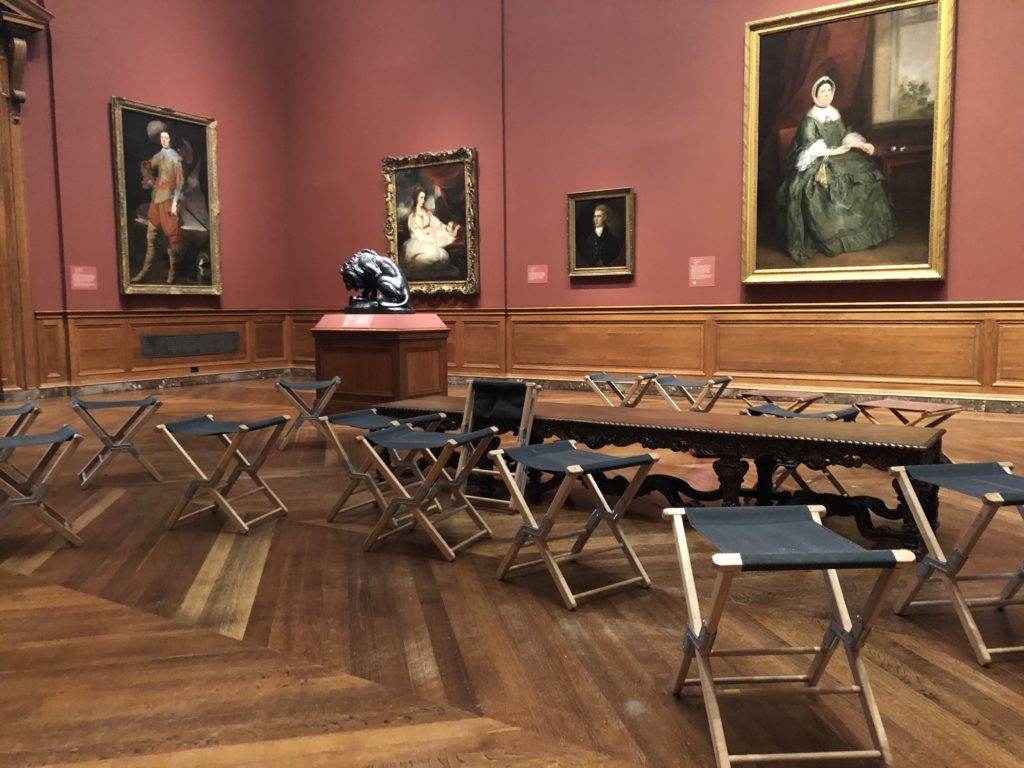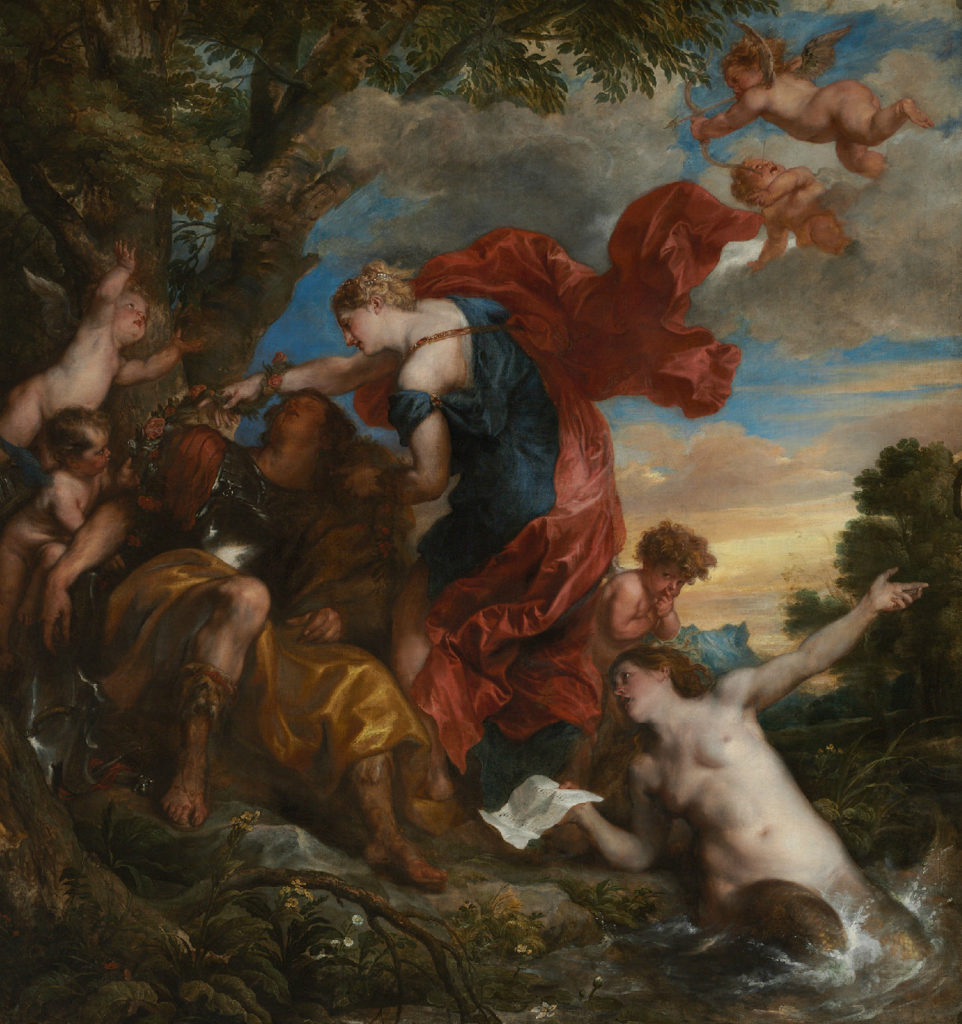Takeaway
The art of medicine must balance stillness and motion. Making time to reflect can infuse more meaning in our interactions with patients.

Lifelong Learning in Clinical Excellence | September 4, 2019 | 7 min read
By Kamna Balhara, MD, Johns Hopkins Medicine
As their initial excited dialogue died down, the new interns settled into a focused hum of conversation. They went from room to room, triaging and examining patients, formulating plans and diagnoses, and presenting findings to colleagues.
This, however, was no ordinary shift.
Instead of the hallways of the emergency department, the interns were roaming the galleries of the Baltimore Museum of Art. Their patients were not flesh and blood, but were pigment, paint, and paper; instead of the bedside, the interns were practicing the art of medicine at the frameside. Accompanied by emergency medicine faculty and museum educators, the interns were visiting the museum during their orientation to residency as part of the Health Humanities at Hopkins Emergency Medicine initiative (@HealthHumJHEM).
New to the museum, new to the city, and new to residency, the interns used this visit to get to know Baltimore and its cultural milieu, connect with their new colleagues outside the clinical arena, and practice their observation, deduction, and communication skills. As I traversed the galleries together with the interns, I realized that the museum served yet another purpose: that of a portal to appreciating the power of pauses and perspectives both in our personal and professional lives.

The pause as present, presence, and permanence
During the visit, we were invited to observe a piece of art before delving into discussion. We carried folding stools with us through the galleries, and, with the simple act of having a chair in hand, felt empowered to take a seat.
We felt empowered to pause.
We visibly relaxed. We saw things we hadn’t seen before. We looked before we leapt.
While a cursory glance through the museum’s Antioch Court would have yielded dusty tiles on a 5th century mosaic, our steady seated gaze revealed the stories embedded in the fish, birds, and flowers pieced together from those tiles. The momentary stillness of the pause created fertile ground for observation and reflection. Together, we sat in companionable silence, and though we were static, time paradoxically seemed to expand; in pausing in the present, we were able to contemplate the history and the past of the “Striding Lion“ mosaic. In this pause, we let both our gazes and our minds wander, taking in the artwork, our surroundings, and our own responses to the mosaic to gain a more meaningful understanding of this ancient piece of pavement.
I found myself wondering then about how we approach the pause in clinical care. Our patients often experience stillness; they spend much time waiting for a bed, a procedure, a prognosis. As physicians, we are often taught to take a verbal pause after an open-ended question. How often, however, do we take a physical or visual pause the way we did in those galleries?
Under the myriad pressures of overcrowding, billing, and overbooked clinics, it is easy to fall prey to practicing medicine in a hurry, relying upon a fleeting cursory glance to construct our patients’ stories. Often, that glance is directed anywhere but the present. With increasing reliance on electronic health records, we are often looking backwards to the ghosts of visits past, wading through prior hospitalizations or test results to inform our perceptions of the present. With an eye on the clock, we also spend much of our time looking ahead, expeditiously establishing care plans and determining dispositions to get to the next patient in line. Despite our frenetic, distracted gazes, however, the current patient is firmly situated in the present.
Perhaps a pause is just what the doctor ordered to meet our patients where they are, not only for their well-being, but also our own. That moment of pause anchors us firmly to the present, gently redirecting our harried gaze from the past and the future to the current moment and the patient before us. The pause is presence; it signals to our patients that we are committed to not just seeing, but looking, and not just hearing, but listening. The pause is permanence, it conveys a simple, “I’m here with you.” Amidst the disorienting chaos of navigating the ever-changing tides of the hospital or healthcare system, the fixity of the pause allows both for us and our patients to serve as each other’s immutable North Stars. The pause assures patients we are here to walk alongside them as they traverse illness and health, and, in refocusing our gaze on the patient, the pause reminds us of the true meaning of our work.
While stillness is not often seen as a virtue in medicine, our shared experience of purposeful pauses in the museum gave us an opportunity to practice it alongside our new physicians. Hearteningly, our new residents found value in those moments of pause; Stephannie Acha-Morfaw noted how our museum visit highlighted “how what we feel and what we sense and what we see can tell a story that gives us a deeper understanding of our patients and the lives they’ve lived.”

Perspective: looking outside the box
As we walked through the galleries and took our pauses, we tended to arrange our seats in an orderly row. We stopped in front of Anthony van Dyck’s “Rinaldo and Armida,” an enigmatic 17th century painting of life-sized proportions. After an initial observation period from this vantage point, however, the group was then instructed to move around the space. Some chose to get close to the image, suddenly noting the hidden face in a tree trunk or a cherub’s sly smile. Moving adjacent to the painting revealed details previously hidden under the direct glare of spotlights. Stepping back illustrated the undulating, serpentine lines of the painting. The experience was punctuated by moments of discovery; “I hadn’t seen that before!” was a common refrain as we changed our assumed perspectives and actively sought new information.
In patient care, we often tread the well-worn paths of our typical routines. Perhaps we do not stray often enough from our practiced positions or spaces of sanctuary, be they at the foot of the bed or behind the blue glow of the computer screen. In our clinical environments, we should feel free move around those spaces, to not just think outside the box, but look outside the box.
This shift in perspective is not just spatial; meaningful engagement with others can also provide depth and discovery in our encounters. In discussing Alice Neel’s “Nancy with Twins,” a powerful image of a mother breastfeeding her twins, some saw dejection, others saw defiance; in sharing those opposing points of views, we all saw something we hadn’t seen before. In reflecting together and in sharing those reflections, our group experienced a virtual shift in perspective, momentarily inhabiting different points of view. “It showed me how much I can learn from the rich and varied perspectives my colleagues bring to or practice,” Stephannie Acha-Morfaw noted. We also realized how our own perspectives shaped what we saw. When asked to choose a portrait to examine, we “triaged” based upon which portraits resonated with us as individuals; our lived experiences guided which “portrait patient’s” plight seemed most acutely in need of our attention.
This pause from clinical activity at the museum also afforded us some personal perspective. For the faculty in the group, this visit was reinvigorating; in seeing and sharing these works of art with a new generation of clinicians in a new environment, we felt reconnected to humanity: theirs, ours, and that of our patients. For some of our newly-minted residents, the preclinical pause at the museum served as an opportunity to reconcile old lives with new. Joshua Niferatos wrote, “It felt rejuvenating. I needed to drink from a well of creativity during intern orientation to reorient new myself to my old self.” For others, this was a moment to reflect upon the great adventure and challenge that lies ahead. Keith Calhoun and Chandra McCormick’s powerful monochrome photography reminded Kyle Burton of the pull he feels to serving “those often wronged by inhumane institutions” and of the need to see “the big picture” in our “incredible commitment” to our patients. From the frameside to the bedside, this detour out of the clinical environment allowed us to immerse ourselves more deeply and meaningfully in the practice of medicine.
Thank you to Stephannie Acha-Morfaw, Joshua Niforatos, and Kyle Burton for sharing their reflections.

